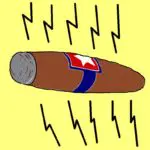The PicoVNA 108 8.5 GHz analyzer now includes automated E-Cal calibration and TRL/TRM calibration.
The PicoVNA 108 achieves calibration automation through either male SMA or female SMA E-Cal modules. These are USB-powered and controlled to electronically select the various short, open, load and through reference standards as they are needed within the calibration process. You simply power the module, make a single connection of the E-Cal standard between the PicoVNA test ports, and then initiate the automated procedure from within the PicoVNA 108 user interface.
The switches, it can be argued, introduce undesirable sources of error to the calibration process. The Pico trick is to mitigate these  errors by characterizing and correcting for them as fully as possible, and by controlling temperature and temperature gradients through the heating of a thermal island within the device. RF Business Development Manager Mark Ashcroft claims that Pico achieves its high-coverage characterization through unique processing of no less than seventeen device S-parameters. The resulting residual errors of a PicoVNA E-Cal calibration are amongst the lowest achievable and can compare favourably with those arising from the repeated connect-disconnect and test lead flexing of the equivalent manual approach.
errors by characterizing and correcting for them as fully as possible, and by controlling temperature and temperature gradients through the heating of a thermal island within the device. RF Business Development Manager Mark Ashcroft claims that Pico achieves its high-coverage characterization through unique processing of no less than seventeen device S-parameters. The resulting residual errors of a PicoVNA E-Cal calibration are amongst the lowest achievable and can compare favourably with those arising from the repeated connect-disconnect and test lead flexing of the equivalent manual approach.
Within their supplied carry and storage case, Pico include a fully characterized, polarized port adapter with each of their E-Cal modules; allowing both the male and female SMA devices to also calibrate insertable male-female and female-male test ports.
TRL (Through Reflect Line) and TRM (Through Reflect Match) calibration typically gain favor when needing to measure substrate-mounted DUTs, for example surface-mounted networks or components on a PCB or ceramic. The necessary transmission lines, low-frequency match and reflections (shorts or opens) can all be readily fabricated at precise on-substrate measurement reference planes. Additionally, if necessary, the calibration will account for the environmental conditions and any variability of the test substrate.
Whilst the TRM technique can readily address lower frequencies (in practice below around 1.5 GHz), the TRL technique employs a reference line length, of significantly more than 0° phase delay and significantly less than 180°. Thus, a single TRL line can address a limited frequency band. In the case of the PicoVNA 108 one line is generally sufficient, but two TRL bands are supported and can account for line impedance offset if required. The low‑frequency TRM band can reference a readily fabricated on-substrate resistive match.
TRL also gains favor in precision measurement circles because a machined air transmission line can be fabricated more precisely than a good match can be measured; certainly at higher frequencies. As this line standard can carry the burden of time (phase) and high-frequency match calibration, the additionally needed low and high reflection standards, the match, shorts or opens, can be precisely positioned but less well known.
Existing users can add both E-Cal and TRL/TRM functionality to their PicoVNA 108 using the free-of-charge software update from the download page. PicoVNA instruments and accessories come with a comprehensive three-year warranty.
Pico Technology, 320 N Glenwood Blvd., Tyler, TX 75702, +1 800 591 2796, fax +1 620 272 0981, www.picotech.com






Leave a Reply
You must be logged in to post a comment.